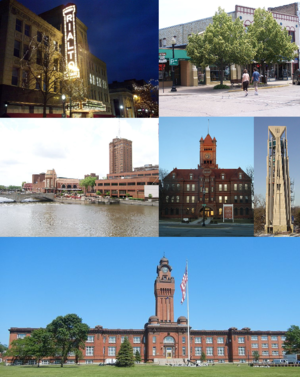Collar counties
This article needs attention from an expert in Illinois, U.S. Counties or American politics. The specific problem is: Needs expansion and updates, especially by people who closely follow Illinois politics. (September 2018) |
Collar Counties | |
|---|---|
 Clockwise from top left: Rialto Square Theater (Joliet), Downtown Crystal Lake, Moser Tower (Naperville), Old DuPage County Courthouse (Wheaton), Great Lakes Naval Training Station (North Chicago) and Downtown Aurora. | |
 | |
| Country | |
| State | |
| Counties | DuPage, Kane, Lake, McHenry and Will. |
| Settled | 1770s |
| Named for | Their mutual proximity to and surrounding of Cook County. |
| Population (2012 Estimate) | |
| • Total | 3,143,257 |
| Time zone | UTC−06:00 (CST) |
| • Summer (DST) | UTC−05:00 (CDT) |
| Area code(s) | 224, 331, 630, 779, 815, 847 |
The expression the collar counties is a colloquialism for the five counties of Illinois that border Chicago's Cook County. After Cook County, they are also the next five most populous counties in the state. According to the Encyclopedia of Chicago, there is no specifically known origin of the phrase, but it has been commonly used among policy makers, urban planners, and in the media. However, it also notes that as growth has spread beyond these counties, it may have lost some of its usefulness.[4]
The collar counties (DuPage, Kane, Lake, McHenry, and Will) are tied to Chicago economically. However, like many other suburban areas in the United States, the collar counties have somewhat different political leanings from the core city. Chicago has long been a Democratic stronghold, while the collar counties historically tilted Republican. In recent elections, however, the collar counties have voted for Democrats, but with lower margins than Cook County.
While the demographics of these suburban Chicago counties are fairly typical for American metropolitan areas, the term is apparently unique to this area. Also, because Cook County is so firmly entrenched in the Democratic column, and rural Downstate is overwhelmingly Republican, the collar counties are routinely cited as being the key to any statewide election.[5][6][7] However, that conventional wisdom was challenged in 2010 as Democrat Pat Quinn won election as governor while only winning Cook, St. Clair, Jackson and Alexander counties.[8] All five collar counties went Republican, so the key to winning that gubernatorial election was simply winning Cook County, but by a wide enough margin to overwhelm the rest of the state.[9]
While the term is often employed in political discussions, that is not its exclusive use.[10][11] Barack Obama used the term in his speech before the Democratic National Convention in 2004.[12]
As of 2010 there are 3,143,257 people residing in the collar counties, nearly 25% of the population of Illinois. Combined with Cook County the area has approximately 65% of Illinois's population.
See also
- Lake County, Indiana
- Hamilton County, Indiana
- Chicago metropolitan area
- The St. Louis, Missouri Metro-East region of Illinois (Madison County, Illinois, St. Clair County, Illinois, Montgomery County, Illinois, Macoupin County, Illinois, Jersey County, Illinois, Bond County, Illinois, and Adams County, Illinois)
- Orange County, California
- Long Island
- Northern Virginia
- Cobb County, Georgia
- Gwinnett County, Georgia
- WOW counties
- Philadelphia metropolitan area
References
- ^ Field, Nick; October 25, Pennsylvania Capital-Star; 2019 (October 25, 2019). "How the Pa. electorate has changed since 2016 and what that means for 2020 | Analysis". Pennsylvania Capital-Star. Retrieved September 22, 2020.
{{cite web}}:|last3=has numeric name (help)CS1 maint: numeric names: authors list (link) - ^ Otterbein, Holly. "Pennsylvania suburbs revolt against Trump". POLITICO. Retrieved September 22, 2020.
- ^ Bond, Michaelle. "The Philadelphia suburbs turned blue in a big way. What do Democrats plan to do with their new power?". inquirer.com. Retrieved September 22, 2020.
- ^ Mariner, Richard D. (July 10, 2018). "Collar Counties". The Electrictronic Encyclopedia of Chicago. Chicago, IL: Chicago Historical Society (2005), Newberry Library (2004).
- ^ "Archived copy". Archived from the original on December 19, 2013. Retrieved February 13, 2011.
{{cite web}}: CS1 maint: archived copy as title (link) - ^ "'Quinn-Brady race may be decided in collar counties". Chicago Sun-Times. Archived from the original on October 19, 2010. Retrieved February 13, 2011.
- ^ "Why the Collar Counties are Trending GOP". NBC Chicago. Retrieved September 13, 2013.
- ^ "Error Display". elections.il.gov. Archived from the original on September 21, 2013. Retrieved August 7, 2012.
- ^ Illinois gubernatorial election, 2010
- ^ Mount, Charles (May 30, 1989). "Collar Counties Cutting Court Backlogs". Chicago Tribune. Retrieved September 13, 2013.
- ^ "Collar County Homepage". socqrl.niu.edu. Archived from the original on March 20, 2012. Retrieved February 13, 2011.
- ^ https://www.pbs.org/newshour/show/barack-obamas-keynote-address-at-the-2004-democratic-national-convention
